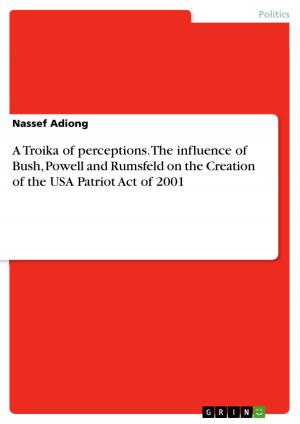| Author: | Yuliya Asmolovskaya | ISBN: | 9783640586226 |
| Publisher: | GRIN Publishing | Publication: | April 7, 2010 |
| Imprint: | GRIN Publishing | Language: | English |
| Author: | Yuliya Asmolovskaya |
| ISBN: | 9783640586226 |
| Publisher: | GRIN Publishing |
| Publication: | April 7, 2010 |
| Imprint: | GRIN Publishing |
| Language: | English |
Seminar paper from the year 2009 in the subject English Language and Literature Studies - Linguistics, grade: 1,3, University of Hamburg (Institut für Anglistik und Amerikanistik), course: Highlights in Cognitive Linguistics, language: English, abstract: The emerging ability for blending different mental spaces, so argue Fauconnier and Turner (2002: V), allowed humans to gain the upper hand over competing species from the Upper Paleolithic onwards, since this ability gave them the imagination required to invent new concepts, tools and means of communication (among them language). On the basis of this discovery and the initially developed Mental Space theory, Fauconnier and Turner advanced a striking theory called the Conceptual Blending theory. [...] Therefore, in this term paper I focus entirely on jokes, which I attempt to interpret by means of the Blending theory. To investigate cognitive processes involved in joke comprehension, I have interviewed four English native speakers with the intention of finding whether all of them are able to explain why the joke is funny and which incompatible elements are responsible for its humorous effect. Taking into account the participants' answers I have tried to define the input spaces (by naming their constituents) and the blended space. Additionally, the participants' answers were evaluated with regard to the role of background knowledge, which is necessary in order to comprehend the joke. Finally, I examined whether the Conceptual Blending theory might be applicable for the analysis of joke processing and comprehension in general and what difficulties can arise during the creation of the input spaces and the blend. Thus, in the following sections I will first introduce important information on conceptual blending and then analyze selected jokes according to the Conceptual Blending theory, taking into consideration the interviewees' explanations of the jokes. Central to Conceptual Blending theory is the notion of the conceptual blending network (or conceptual integration network), an array of mental spaces in which the processes of blending unfold (Fauconnier and Turner, 1998b). A basic conceptual integration network contains four mental spaces: two input spaces, a generic space and a blended space (see Figure 1). Input spaces are on-line conceptual representations constructed under the influence of the incoming information but tapping stored cognitive models. [...]
Seminar paper from the year 2009 in the subject English Language and Literature Studies - Linguistics, grade: 1,3, University of Hamburg (Institut für Anglistik und Amerikanistik), course: Highlights in Cognitive Linguistics, language: English, abstract: The emerging ability for blending different mental spaces, so argue Fauconnier and Turner (2002: V), allowed humans to gain the upper hand over competing species from the Upper Paleolithic onwards, since this ability gave them the imagination required to invent new concepts, tools and means of communication (among them language). On the basis of this discovery and the initially developed Mental Space theory, Fauconnier and Turner advanced a striking theory called the Conceptual Blending theory. [...] Therefore, in this term paper I focus entirely on jokes, which I attempt to interpret by means of the Blending theory. To investigate cognitive processes involved in joke comprehension, I have interviewed four English native speakers with the intention of finding whether all of them are able to explain why the joke is funny and which incompatible elements are responsible for its humorous effect. Taking into account the participants' answers I have tried to define the input spaces (by naming their constituents) and the blended space. Additionally, the participants' answers were evaluated with regard to the role of background knowledge, which is necessary in order to comprehend the joke. Finally, I examined whether the Conceptual Blending theory might be applicable for the analysis of joke processing and comprehension in general and what difficulties can arise during the creation of the input spaces and the blend. Thus, in the following sections I will first introduce important information on conceptual blending and then analyze selected jokes according to the Conceptual Blending theory, taking into consideration the interviewees' explanations of the jokes. Central to Conceptual Blending theory is the notion of the conceptual blending network (or conceptual integration network), an array of mental spaces in which the processes of blending unfold (Fauconnier and Turner, 1998b). A basic conceptual integration network contains four mental spaces: two input spaces, a generic space and a blended space (see Figure 1). Input spaces are on-line conceptual representations constructed under the influence of the incoming information but tapping stored cognitive models. [...]















